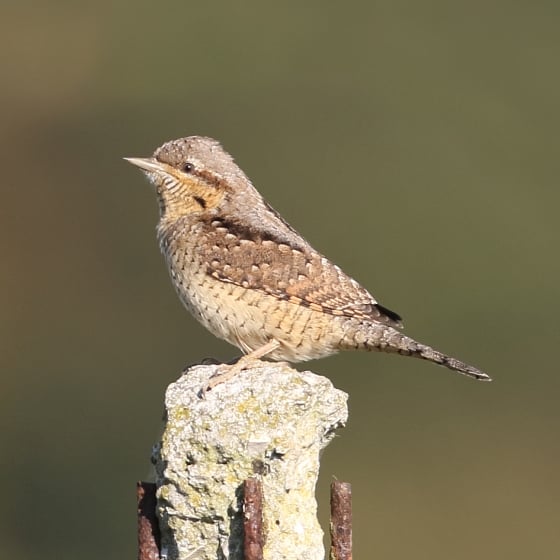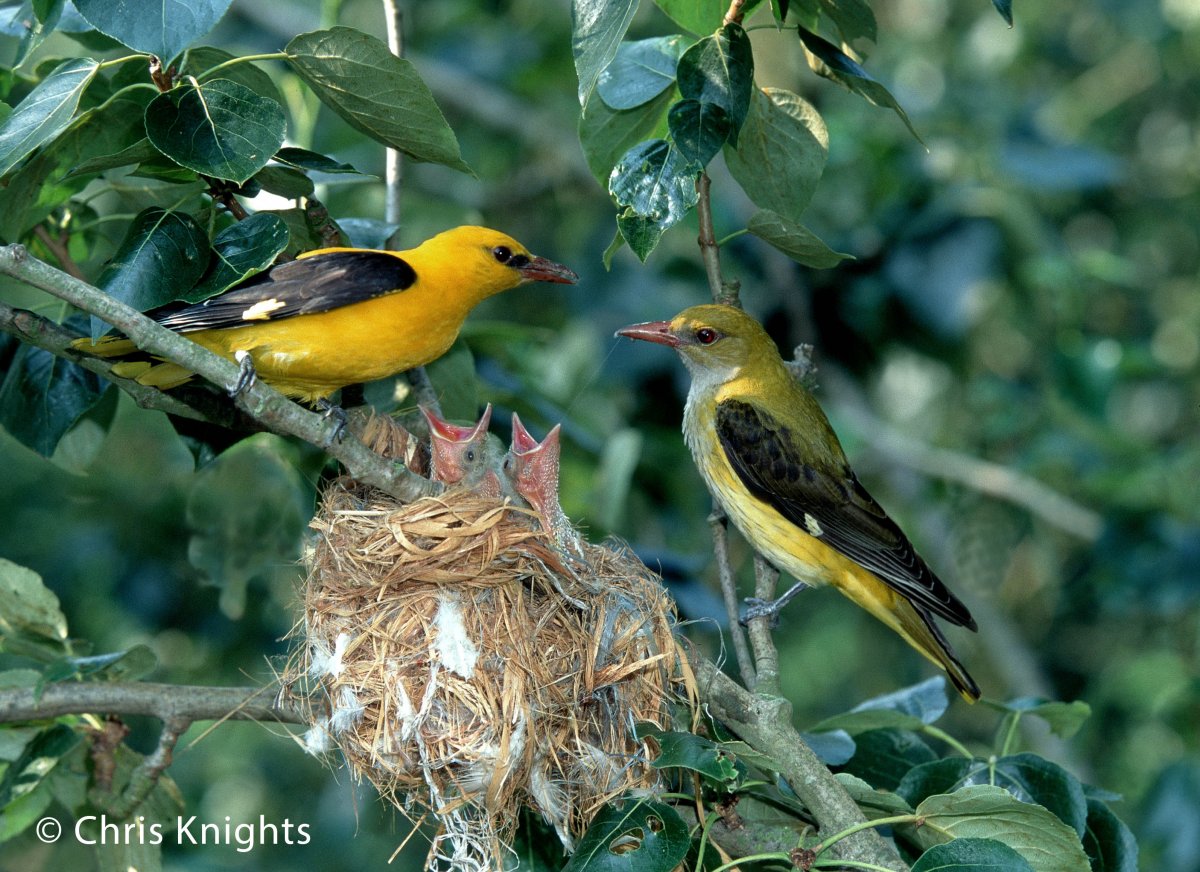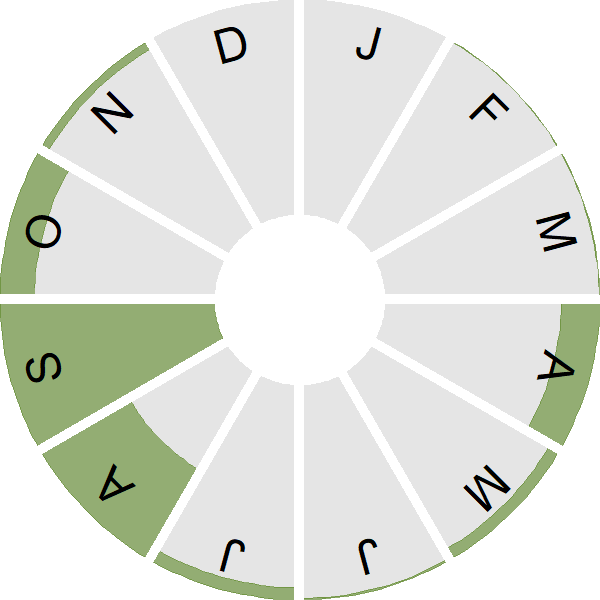Wryneck

Introduction
This former breeder was once a common bird across much of central and southern England, favouring commons, heathland, orchards, parkland and larger gardens.
This small woodpecker, with its delicately-patterned plumage, is now only a very occasional breeder and typically only seen on passage during autumn and spring.

Key Stats
Identification
Songs and Calls
Song:
Status and Trends
Conservation Status
Population Size
Population Change
Historically, the Wryneck was a widespread breeding species in the UK (Monk 1963) but substantial declines have occurred and the last confirmed breeding record was in 2002 (RBBP data). Occasional records of singing males still occur but the species is believed to be extinct as a breeding species in the UK.
Distribution
A former breeder, Wrynecks were not confirmed to breed during Bird Atlas 2007–11. Possible breeding evidence was recorded in 12 10-km squares and probable breeding was noted in just one square. Most records were in the Scottish Highlands, with a marked concentration in Strathspey, and refer to singing males.
Occupied 10-km squares in UK
2007/08–10/11
or view it on Bird Atlas Mapstore.
2008–11
or view it on Bird Atlas Mapstore.
European Distribution Map
Distribution Change
Change in occupied 10-km squares in the UK
from 1981–84 to 2007–11
or view it on Bird Atlas Mapstore.
from 1968–72 to 2008–11
or view it on Bird Atlas Mapstore.
Seasonality
Wryneck is a former breeding species, now rare passage migrant of early spring. It is more likely to be encountered in autumn, especially in August and September.
Weekly pattern of occurrence
The graph shows when the species is present in the UK, with taller bars indicating a higher likelihood of encountering the species in appropriate regions and habitats.

Movement
Britain & Ireland movement
Foreign locations of birds ringed or recovered in Britain & Ireland
Dots show the foreign destinations of birds ringed in Britain & Ireland, and the origins of birds ringed overseas that were subsequently recaptured, resighted or found dead in Britain & Ireland. Dot colours indicate the time of year that the species was present at the location.
- Winter (Nov-Feb)
- Spring (Mar-Apr)
- Summer (May-Jul)
- Autumn (Aug-Oct)

European movements
EuroBirdPortal uses birdwatcher's records, such as those logged in BirdTrack to map the flows of birds as they arrive and depart Europe. See maps for this species here.
The Eurasian-African Migration Atlas shows movements of individual birds ringed or recovered in Europe. See maps for this species here.
Biology
Productivity and Nesting
Nesting timing
Egg measurements
Clutch Size
Survival and Longevity
Survival is shown as the proportion of birds surviving from one year to the next and is derived from bird ringing data. It can also be used to estimate how long birds typically live.
View number ringed each year in the Online Ringing Report.
Lifespan
Survival of adults
Biometrics
Wing length and body weights are from live birds (source).
Wing length
Body weight
Ring Size
Classification, names and codes
Classification and Codes
- Order: Piciformes
- Family: Picidae
- Scientific name: Jynx torquilla
- Authority: Linnaeus, 1758
- BTO 2-letter code: WY
- BTO 5-letter code: WRYNE
- Euring code number: 8480
Alternate species names
- Catalan: colltort comú
- Czech: krutihlav obecný
- Danish: Vendehals
- Dutch: Draaihals
- Estonian: väänkael
- Finnish: käenpiika
- French: Torcol fourmilier
- Gaelic: Geocair
- German: Wendehals
- Hungarian: nyaktekercs
- Icelandic: Gauktíta
- Irish: Cam-Mhuin
- Italian: Torcicollo
- Latvian: titinš
- Lithuanian: eurazine gražiagalve
- Norwegian: Vendehals
- Polish: kretoglów (zwyczajny)
- Portuguese: torcicolo
- Slovak: krutohlav hnedý
- Slovenian: vijeglavka
- Spanish: Torcecuello euroasiático
- Swedish: göktyta
- Welsh: Pengam
- English folkname(s): Snakebird, Cuckoo's Mate
Research
Causes of Change and Solutions
Causes of change
The decline and extinction of this species in the UK is believed to have been driven by a drop in food availability caused by a shortage of bare ground and short vegetation, although a number of other factors may have contributed including agricultural intensification, climate change, an increase in conifer plantations and the effects of pesticides (Balmer et al. 2013).
Publications (1)
The risk of extinction for birds in Great Britain
Author: Stanbury, A., Brown, A., Eaton, M., Aebischer, N., Gillings, S., Hearn, R., Noble, D., Stroud, D. & Gregory, R.
Published: 2017
The UK has lost seven species of breeding birds in the last 200 years. Conservation efforts to prevent this from happening to other species, both in the UK and around the world, are guided by species’ priorities lists, which are often informed by data on range, population size and the degree of decline or increase in numbers. These are the sorts of data that BTO collects through its core surveys. For most taxonomic groups the priority list is provided by the International Union for Conservation of Nature (IUCN) – the IUCN Red List comprises roughly 12,000 species worldwide and their conservation status. However, for birds in the UK, most policy makers refer to the Birds of Conservation Concern (BoCC) list, updated every six years (most recently in 2015). A new study funded by the RSPB and Natural England in cooperation with BTO, WWT, JNCC, and Game & Wildlife Trust has carried out the first IUCN assessment for birds in Great Britain. The study applied the IUCN criteria to existing bird population data obtained from datasets like the BTO/JNCC/RSPB Breeding Bird Survey (BBS). The criteria take into account various factors, most notably any reduction in the size (both in abundance and range) of populations, loss of habitats key to the species, small or vulnerable population sizes, and extinction risk. Alongside this, the criteria look to see if there is a “rescue” effect – such as immigration from neighbouring populations that might boost the population’s numbers, reducing the risk of extinction. The species are then categorised into one of the threat levels below. The results of the new study show that a concerning 43% of regularly occurring species in Great Britain are classed as Threatened, with another 10% classified as Near Threatened. Twenty-three breeding or non-breeding populations of birds were classed as Critically Endangered, including Fieldfare and Golden Oriole (both possibly extinct as breeders), Whimbrel, Turtle Dove, Arctic Skua and Kittiwake, as well as non-breeding populations of Bewick’s Swan, White-fronted Goose and Smew., Over the past 200 years, seven species have gone extinct as breeders in Britain, including Serin, Temminck’s Stint and Wryneck in the past 25 years. The total percentage of threatened birds in Great Britain (43%) is high compared to that seen elsewhere in Europe (13%). Reasons for this are not entirely clear, although it may be that Britain’s island status has something to do with this, as there are fewer neighbouring “rescue” populations. Although the results from the IUCN assessment and BoCC assessment largely overlap, the IUCN assessment raises the level of concern for species such as Red-Breasted Merganser, Great Crested Grebe, Moorhen, Red-Billed Chough (all classed as Vulnerable), and Greenfinch (Endangered). These species might thus warrant closer monitoring in the near future. In contrast, the BoCC assessment identifies a number of species of concern whose declines have been more gradual but over long time periods (e.g. Skylark and House Sparrow). The authors emphasise that this assessment is not a replacement of the BoCC report, but rather that the two reports complement each other. With this new wealth of knowledge, there will hopefully be even more support for those species that need it most.
01.09.17
Papers

More Evidence
More evidence from Conservation Evidence.com
Partners
Citing BirdFacts
If you wish to cite particular content in this page (e.g. a specific value) it is best to use the original sources as linked in the page. For a more general citation of the whole page please use: BTO (20XX) BirdFacts Species: profiles of birds occurring in the United Kingdom. BTO, Thetford (www.bto.org/birdfacts, accessed on xx/xx/xxxx).

